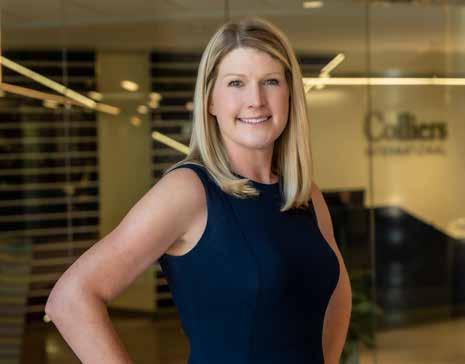
13 minute read
Healthcare Building
from AZRE May/June 2021
by AZ Big Media
ADVANCED TREATMENT
Here’s how health care facilities are preparing for tomorrow’s pandemic, today By KYLE BACKER
It’s been more than a year since the World Health Organization declared the COVID-19 outbreak a pandemic and the first related deaths were reported in the U.S. During the height of the pandemic, hospital systems were stressed as available beds ran dangerously low in cities across the country and health care workers grappled with treating patients and finding a way to control transmission of the highly contagious virus.
“The pandemic did something unique to the health care system — it pushed it to the max,” says Lee O’Connell, vice president of operations for McCarthy Building Companies Southwestern Region’s health care services group. “We’re able to look in the rearview mirror now and see it was the system and the people that pushed through.”
The urgency of the COVID-19 pandemic may soon fade, but the lessons hospitals learned last year won’t be forgotten as new health care facilities continue to be designed, developed and opened to the public. We take a look at four projects in the Valley that are already preparing for the possibility of future outbreaks, along with construction trends that are guiding development.
CHANDLER REGIONAL MEDICAL CENTER
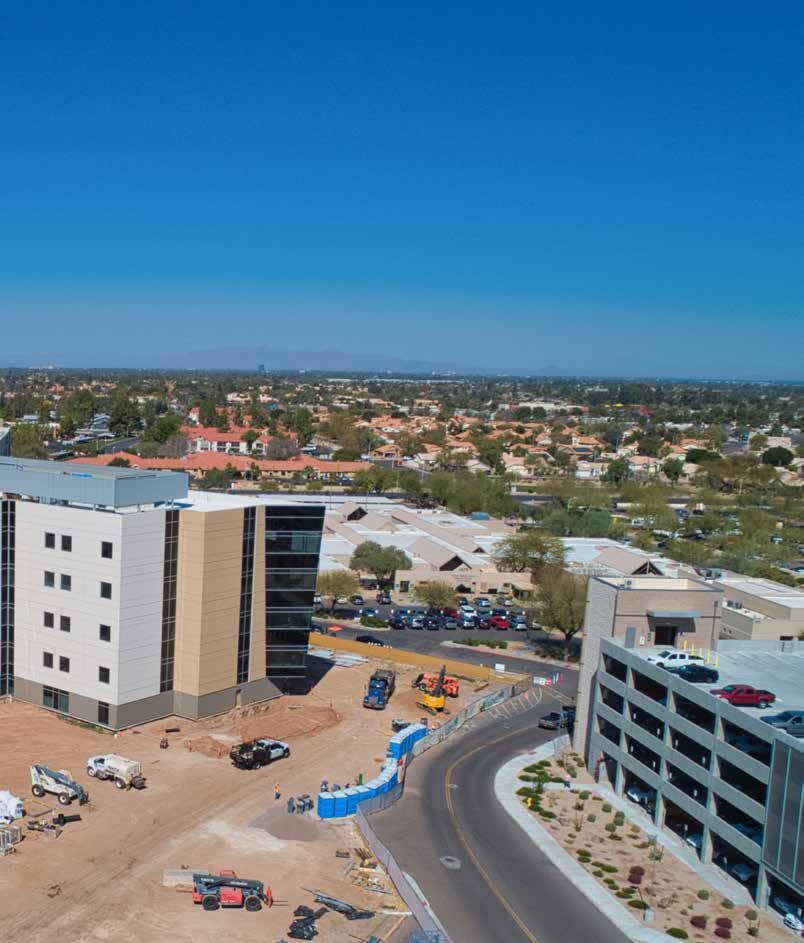
VALLEYWISE HEALTH MEDICAL CENTER
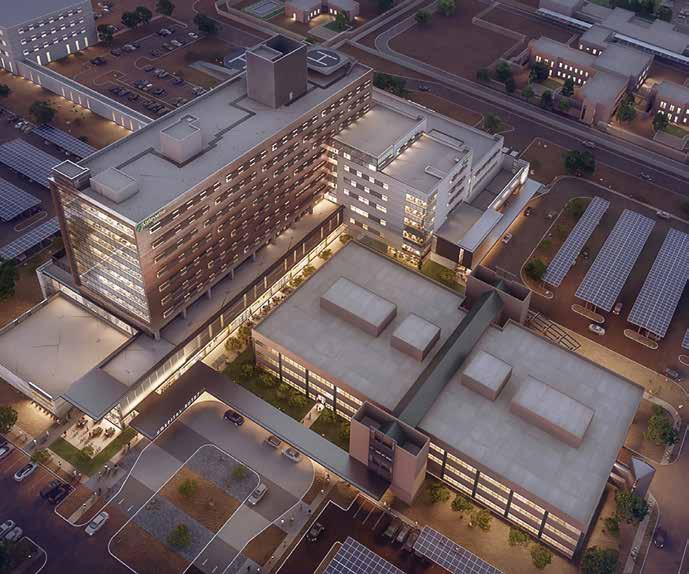
CHANDLER REGIONAL MEDICAL CENTER
Part of the Dignity Health system, the Chandler Regional Medical Center tower addition and expansion is slated to open in June 2021. The expansion is a design-build contract, meaning the owner, designer and construction partners collaborated on the project from the start.
“We deliver full-service contractor services where we’re planning the medical equipment, the furniture, the artwork and signage in the facility,” says Nicholas Pearce, project director for McCarthy Building Companies. “Being involved from the beginning means doctors and nurses will be able to provide care right away when we hand over the keys to the owner.”
The 225,000-square-foot patient tower, known as Tower D, will bring the facility’s total bed count to 429, with space on the first and fifth floors for future growth. McCarthy Building Companies is also renovating an additional 55,000 square feet in Tower C, which opened in 2014 and houses a Level 1 trauma center and intensive care unit. The project will create eight new surgical suites and the expansion of outpatient services. Tower C renovations will be complete in 2022.
VALLEYWISE HEALTH MEDICAL CENTER
In 2014, Maricopa County voters approved a $935 million bond in part to replace Valleywise Health Medical Center, its Level 1 trauma center and the Arizona Burn Center. The original hospital was designed during the 1960s under a different care model that subscribed to lengthy patient stays. “Hospitals are moving towards performing elective surgeries in outpatient ambulatory centers and allowing the acute-care facilities to focus on the more critical cases,” says Mark Tiscornia, principal for Cuningham Group Architecture, which partnered with design group EYP on the project.
Part of the expansion includes creating a designated floor for the Arizona Burn Center with its own entrance, lobby and signage. Previously, the center’s resources were spread throughout the hospital.
An additional support building will meet the needs of a major hospital.
“The program is about 675,000 square feet of new hospital and 100,000 square feet of the support service building which is connected by a breezeway. It is 10 stories with 233 licensed beds and a shell floor at the very top to give the system an opportunity for potential expansion in the future,” Tiscornia says. The expansion is projected to be completed in 2023.
BANNER HEALTH
Nonprofit Banner Health is investing nearly $400 million in expansion projects in the East Valley, including Banner Desert Medical Center in Mesa and Banner Gateway Medical Center in Gilbert. Even before the pandemic, the region’s growing population warranted an expansion of services.
The Mesa project, slated for completion in 2023, includes 148,800 square feet of new space and 102,500 square feet of renovated space; it also adds 152 adult acute care beds.
“We are building a women’s tower that will include state-of-the-art services for women and infants, a new women’s surgical services unit, and other medical and surgical units to support the growth of this campus,” says Laura Robertson, CEO of Banner Desert and Banner Children’s at Desert. “With this tower next to our pediatric tower, we will create a focused women’s and children’s
BANNER DESERT
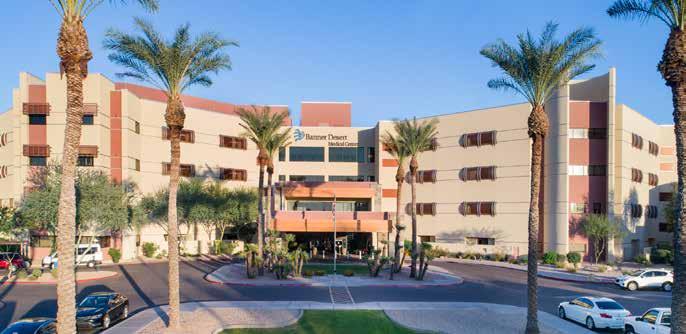
BANNER GATEWAY


Claire Agnew Lee O’Connell Nicholas Pearce Laura Robertson Mark Tiscornia Lamont Yoder
strategy to serve as a leader for those services in the East Valley.”
A portion of the remodel, designed by Cuningham, seeks to synergize the campus’s women and children’s programs. “The existing lobby for Cardon’s Children’s Hospital had a lot of pediatric-focused elements and, as the women’s program was brought into the building, Banner tried to create a joint feeling that was more sophisticated but still pediatricfriendly,” Tiscornia says.
In mid-March, McCarthy broke ground on a 350,000-square-foot expansion of Banner Gateway Medical Center that will nearly double the size of the campus and address growing needs for women’s and infant services and cancer care.
“We are in a high-growth area, and our capacity has been stretched,” says Lamont Yoder, CEO of Banner Gateway. “Increasing our capacity for expectant moms is a top priority as is ensuring capacity for expected future growth of this community in years to come.”
A five-story 208,500-square-foot patient tower will bring 109 new patient beds to the facility, for a total of 286, with an ability to add 72 extra beds once the shelled space is built out. Also included are an 85,000-squarefoot expansion of campus’s west side diagnostics and treatment building and a two-level addition to the existing diagnostics and treatment building on the east side of campus. Completion is planned for 2023.

TRENDS IN DEVELOPMENT
During the height of the pandemic, hospital systems were stressed as available beds ran dangerously low. For many facilities, that meant halting elective surgeries and adapting spaces into patient quarters. “We started off by converting our pediatric emergency room into an incident decision unit, which is dedicated to caring for COVID-19 patients,” says Claire Agnew, chief financial officer for Valleywise Health.
If the past year has shown us anything, it is that the COVID-19 pandemic revealed the precarious nature of day-to-day life. Planning for adaptability, O’Connell suggests, is one solution to future emergency situations. “Infrastructure can be done differently,” he says. “Medical gas can be run into conference rooms where, in an emergency situation, beds can be moved in to. We are already looking into developing rooms that have the ability to transform into a negative pressure, or isolation, environment.”
Having multipurpose spaces also caters to another growing trend: telehealth. Valleywise Health conducted more than 100,000 telehealth visits since rolling out its service, Doxy.me, in March 2020. “We are seeing a lot of multipurpose collaboration rooms at Chandler Regional Medical Center with audiovisual setups for providing telehealth care in a private scenario. Multipurpose spaces are useful because they’re not locked into one thing as care adjusts over time,” Pearce explains.
While no one can predict the future, it can be planned for. And health care facility administrators, designers and builders are doing just that, according to Tiscornia. He notes, “There’s a continued urgency to plan and design facilities that will allow them to be prepared for anything that comes their way, whether it’s lack of water or power — or a future pandemic.”
TELEHEALTH: The demand for telehealth grew rapidly during the pandemic.
Getting Better With Age
Senior housing developments are evolving to meet the future needs of discriminating residents
By REBECCA L. RHOADES
America is aging. According to the U.S. Census Bureau’s National Population Projections, in the next few decades, 1 in every 5 residents will be older than age 65, a number that’s projected to outpace those younger than 18 for the first time in history.
“There are 10,000 people turning 65 every day in our country,” notes Sharon Harper, chairman, CEO and co-founder of Plaza Companies, which develops and manages three retirement communities in Arizona: Vi at Grayhawk and Vi at Silverstone, both in Scottsdale, and Splendido at Rancho Vistoso in Tucson. “By 2050, the senior population will have doubled to 90 million.” More specifically, the number of adults ages 85 and older will nearly quadruple. And as people age, their needs — from housing to wellness — change. To keep up with these ever-shifting lifestyles, senior living communities are also evolving, offering innovative care models, an abundance of amenities and levels of luxury previously unheard of in both independent- and assisted-living environments.

FOCUS ON LOCATION
Traditionally, age-restricted communities were located outside of urban centers, but members of the baby boomer generation — now ages 57-75 — don’t wish to give up all of the conveniences and activities of everyday life.
When Mirabella at ASU welcomed its first residents in December 2020, it signaled an exciting new category of senior living. Developed in partnership with the ASU Foundation, the 630,000-square-foot 20-story high-rise complex sits on university land and caters to adults ages 62 and older who wish to maintain an active and intellectually stimulating lifestyle. “There’s a
certain energy that comes with living on a university campus,” says Paul Riepma, senior vice president of sales and marketing for Pacific Retirement Services. “Arizona State University’s vision was to serve a broader community, not just 18-to-22-yearolds. Each person who lives here has a Mirabella at ASU student ID card that provides them access to about 200 different classes, passes to the school’s library and museums, and preferred seating to entertainment and sporting events.”
In 2014, LivGenerations opened its first Valley community in the heart of Agritopia in Gilbert. The desirable garden neighborhood is not only popular with young families but also provides easy access to numerous restaurants, golf, shopping and transportation. The company is currently completing construction on its fourth Arizona development. Located on Mayo Boulevard, it’s minutes away from Mayo Clinic and near an active corner of North Scottsdale Road. “We really thought methodically about where we’re going to place our communities,” says Sonya Paterno, regional director of sales for LivGenerations. “The traditional model of senior living isn’t what people want these days. We still cater to a mature population in a communaltype setting, but the residents want to have fun and have access to all of the amenities they’re used to.”
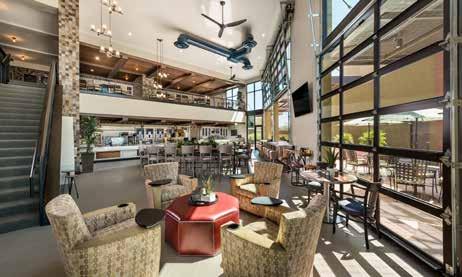
RESORT-STYLE LIVING

Along with location, seniors expect to maintain the same high level of comfort they experienced in their family homes. They seek boutique offerings that focus on unique experiences rather than one-size-fitsall decor and dining.
At Mirabella at ASU, living quarters are on par with the Valley’s poshest apartment complexes, with high ceilings, walls of windows and top-notch appointments. Founding residents were able to suggest structural changes to their homes, such as the removal of walls, and select lighting, cabinetry and finishes.
Sagewood, a Life Plan Community recently completed a 3.5-acre expansion at its northeast Phoenix property, which included 101 independent living apartments, a new restaurant, conference and game rooms, an art studio and an 18-hole putting course. Residents in the addition could upgrade everything from countertops to flooring, if they desired. “Some of the homes are very customized,” says Ellen Devine, director of marketing for Sagewood.
While independent living quarters offer fully equipped kitchens, today’s senior facilities also feature multiple on-site restaurants, ranging from 24-hour delis to fine dining. Many are also open to the public. Fullservice spas, beauty salons, indoor and outdoor swimming pools, game rooms, wine cellars, hallways lined with rotating exhibits of original art, high-end furnishings in public spaces, dog parks and electric vehicle charging stations are just a few of the many other high-end amenities developers are incorporating to attract discerning residents in a competitive market.
A LIFETIME OF CARE
According to a study by the National Investment Center for Seniors Housing & Care, as the population ages, 8% will have cognitive impairments, 60% will have mobility limitations and 20% will have high needs, defined as three or more chronic conditions and one or more limitations of daily living. Developers of senior housing are anticipating those needs and incorporating advanced treatment centers into their projects.
At Mirabella, Vi at Grayhawk and Vi at Silverstone, and LivGenerations, for example, the first step of occupancy is independent living. As acuity decreases, residents can then move into assisted living apartments, memory care or skilled nursing rooms, or even hospice, all with 24-hour on-site
TÜK URBAN KAFE AT LIVGENERATIONS AHWATUKEE
SPLENDIDO AT RANCHO VISTOSO
Luke Bourlon Ellen Devine Sharon Harper Sonya Paterno Paul Riepma
medical professionals. “It’s not the most pleasant subject to talk about, but if you don’t have all the different levels of health and home care, then you run the risk that residents are going to have a medical problem that can’t be addressed,” says Riepma. This combination of care also eliminates concerns of finding last-minute treatment facilities and allows spouses and partners to remain near their loved ones, offering a greater peace of mind for family members.
POST-PANDEMIC PROTECTION
“One of the things we’re cognizant of going forward is that a lot of the services that our residents would go to to receive are now coming to them,” says Luke Bourlon, president of development for Sparrow Partners, which will be delivering its first senior living units in Arizona this summer in Surprise. The company also has three other projects under construction in Goodyear, Glendale and Mesa. “Take telemedicine, for example. The pandemic has really accelerated the use of technology to provide on-demand physician services without needing to leave home.”
During the past year, as senior living facilities struggled to contain the spread of the coronavirus, Wi-Fi programs kept residents connected to staff; provided in-home access to daily exercise and educational classes; and allowed them to select menu options, with the meals then delivered to their apartments.
As part of its expansion, Sagewood launched its EverSafe 360° program, which incorporates state-of-the-art indoor air-quality systems. “It’s not anything visible to the residents, but it’s a nice feeling, especially during the time of a pandemic when they’re still living in their home and getting ready to make a move to our Phase II addition,” says Devine “Because, let’s face it, people have been scared.”
Outdoor spaces also played a vital role in mental health maintenance. Sagewood offered concerts and bingo nights that residents could enjoy from their balconies, while one of Sparrow’s design mandates is to include enough private outdoor spaces for each unit. Ground floor apartments have private yards, and each development includes a large 6-to-10-acre courtyard with multiple covered patios.
Harper notes that the $50 million renovation and expansion of Splendido at Rancho Vistoso was about threequarters complete when the pandemic struck. “In the case of the villas, we were right on track adding separate heating and cooling systems, sterile hard-surface countertops and infrared lighting,” she explains “Other elements that were helpful in our communities — and this will certainly be enhanced as we go forward — are indoor-outdoor spaces. We always develop our buildings with a sense of wellness factor. During the height of the pandemic, we did ask our residents to stay in their homes, but we also had a lot of private outdoor spaces where they could get fresh air.” Touchless fixtures, automatic doors and sanitizing stations are also becoming commonplace in senior living facilities.
“People are living longer, and they’re much more active between the ages of 75 and 100 than they were 40 years ago,” Reipma says. “They want to remain relevant instead of cocooning in a walled-off retirement community. Seniors today expect more out of their later years.”
MERA CITY CENTER:
Sparrow Partner's first senior living community in Arizona


HACI Mechanical Contractors, Inc. 2108 West Shangri La Rd., Phoenix, AZ 85029 602.944.1555 | hacimechanical.com









